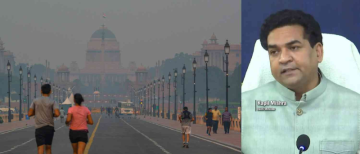Every monsoon, Gurugram makes national headlines for all the wrong reasons. Shiny cars sink in flooded underpasses, commuters spend hours trapped in waist-deep water on arterial roads, luxury apartments costing several crores witness water-filled basements, and once again the “Millennium City” comes across as a city drowning in its own ambition. Videos of citizens wading through waterlogged roads, workers stranded far from their offices, and household items floating in society basements go viral. For a city that was meant to represent India’s urban future, the rains have become an annual reminder of how fragile and unplanned that dream remains
 .
.
This is not just a story of rain. It is a question of governance, accountability, and priorities. For long, political leaders have spoken of the benefits of a double engine government — the same party in power at both the state and the Centre — as the ideal arrangement for fast progress and better management. In theory, Gurugram should have been a showcase of this model. It is wealthy, it contributes heavily to the state’s revenues, it has proximity to Delhi, and it houses multinational headquarters. Yet the city drowns year after year. If even two engines cannot pull Gurugram out of water, then what really can?
The problem lies in the way Gurugram has been allowed to grow. The city’s rise from farmland to skyscraper skyline was swift, but there was no foundation of planning. Natural drains and water channels were covered up to make space for roads and colonies, wetlands were encroached upon, and lakes that once absorbed monsoon water slowly disappeared under the pressure of real estate. Builders constructed high-rises and glass towers, but the invisible parts of a city — drainage lines, stormwater systems, sewage treatment, rainwater harvesting — were ignored in favour of profit and speed. Urbanisation galloped ahead, but the civic body could not even crawl to keep pace. The result is that in today’s Gurugram, a half-hour of intense rain can paralyse the entire city.

It is ironic that the very people who spend crores to buy homes in this so-called global city must spend each July and August planning for flooded basements, broken-down lifts, power cuts, impassable roads, and a surge of mosquitoes hovering over stagnant water. Expensive SUVs and office buses are stuck in the same knee-deep puddles as the two-wheelers of delivery workers. Waterlogging in Gurugram is not just an inconvenience; it is a leveler that spares no one, exposing the weakness of collective management. The dreams sold as “international lifestyle” by builders and endorsed by governments end with residents feeling like victims of mismanagement, forced to live in flooded islands within their societies.
Why is this problem not being solved despite repeated promises? The reasons are as visible as the flooded streets. For one, governance in Gurugram is fragmented. The Municipal Corporation of Gurugram, the Gurugram Metropolitan Development Authority, Haryana Shahari Vikas Pradhikaran, and even the National Highways Authority all share responsibility for parts of the city. But when waterlogging happens, this shared responsibility quickly turns into no-responsibility. Agencies blame one another, and no single authority can be held accountable.

Political will too is short-lived. Just before elections or after a particularly severe monsoon, loud announcements are made about new master plans, additional drainage projects, or redesign of roads. Budgets are sanctioned, but execution remains patchy. Projects go over-budget with little accountability. The case of Hero Honda Chowk, where expensive redesigning still cannot prevent flooding, stands as a textbook example of how money can be spent without results if structural issues are ignored.
It is also important to understand that monsoons are not unknown disasters. They come every year, at almost the same time. Cities like Gurugram should be fully prepared each July, not scrambling reactively once trouble strikes. Annual desilting of drains should be completed before the rains, not during them. Rainwater harvesting should be mandatory and not treated as an optional feature. But this level of preparedness requires both seriousness from authorities and pressure from citizens, neither of which is yet consistent enough to push real reforms.
Meanwhile, the ecological base that could have cushioned the city continues to shrink. Gurugram once had several ponds and lakes that acted like natural buffers. They could absorb excess rainwater while also recharging the groundwater. Today, much of that natural ecosystem has disappeared. Wetlands are built over; catchment areas are choked by development. As a result, water that should have seeped into the ground is left to flood the streets. The natural sponge has been replaced with impermeable concrete.
The cost of this neglect is paid in several ways. Office productivity is lost when thousands of employees cannot reach their workplaces. Families face financial damage when parked cars worth lakhs are destroyed in submerged basements. The health of citizens is endangered by the spread of mosquito-borne diseases in stagnant waters left by the rain. Add to this the constant stress of traffic jams, delays, and ruined daily routines, and it becomes clear that Gurugram’s annual submergence is far more than an inconvenience; it is an urban crisis eating away at the city’s very credibility.

It is possible, however, to change course. Other cities around the world that once suffered similar monsoon flooding have reimagined their infrastructure. The change began not by waiting for miracles, but by accepting the scale of the problem and moving from slogans to action. Gurugram needs a similar seriousness. The first step is accountability. There must be one empowered authority that is answerable for urban flooding. Without a clear line of responsibility, the problem will continue to drift as agencies play the blame game. The second step is to restore what has been lost. Encroached lakes and ponds must be revived. This is not about beautification but about restoring the natural absorption power of the land. Third, drainage systems must match the pace of construction.
A high-rise apartment should not be sanctioned unless its builder has ensured adequate sewage and rainwater planning. Builder responsibility cannot end at selling flats; it must include providing sustainable infrastructure. Fourth, preparation must be shifted from reaction to prevention. Drains must be cleaned in summer, not when rainfall has already begun. Finally, citizens too must play a role. RWAs, residents’ collectives, and citizen groups in Gurugram are already vocal, but their voices must be formally included in urban planning and monitoring.

When frustrations rise, some say none of this will ever change. But cities are living organisms, and they can be corrected with will and determination. Gurugram has the money, it has the human talent, and it has the visibility to take bold steps. What it requires is honesty and political commitment. Without that, slogans of double engines or development mean little when residents are seen pushing their cars out of flooded streets, or when multinational companies send employees home because underpasses are flooded.
At the heart of it lies a simple truth: residents of Gurugram do not demand luxuries from their governments; they merely demand basics — working drains, safe basements, passable roads. That is not an impossible demand for a district that contributes so much to state and national exchequers. The monsoon will return every year, reminding the city of its weaknesses. The only real question is whether leaders in charge will continue to accept humiliation year after year, or whether they will choose to act with resolve.

If two engines cannot pull Gurugram out of water, perhaps it is time to ask if those engines even know which track they are on. A city that represents India’s aspirations must not remain a joke about rain and roads. Gurugram deserves better; its citizens deserve dignity. And fixing waterlogging is the very least that can be done to match the tall promises made to them.
With inputs from agencies
Image Source: Multiple agencies
© Copyright 2025. All Rights Reserved. Powered by Vygr Media.


























